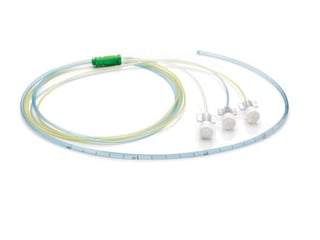 In the following article we are going to summarize this study. The aim of this research paper is to present facts and data to state that simultaneous pressure measurements with WP and AC in a single catheter will provide analogous pressures for Valsalvas, coughs, and maximum pressures in voiding pressure studies (VPS).
In the following article we are going to summarize this study. The aim of this research paper is to present facts and data to state that simultaneous pressure measurements with WP and AC in a single catheter will provide analogous pressures for Valsalvas, coughs, and maximum pressures in voiding pressure studies (VPS).
Understanding What The Study Is About
An urodynamic study (UDS) is a functional test used in the assessment of the lower urinary tract (LUT) in patients with urinary incontinence and related symptoms. This study is considered a standard of care in the urinary incontinence and LUT dysfunctions by most prominent authorities in this field.
Clinical assessment with invasive UDS is performed by measurement of LUT pressures using catheter based manometer systems. Water perfused catheters are the traditional gold standard but the adverse effect on accuracy because of certain factors related to gravity lead to the introduction of air charged catheter technology.
This uses an air column from a balloon to an external transducer which allows circumferential area readings that are gravity independent. There is an on-going argument when it comes to the efficacy of both water perfused and air charged catheter and hence this task to compare simultaneous AC and WP pressures recorded using single catheter setup is quite hard. The aim of the study was to evaluate interchangeability versus variance between the two technologies.
What Type Of Patients Were Involved? What Methods Were Used?
- Women undergoing UDS with LUT symptoms over the age of 21
- Commercially available 7FD or 7FDR TDOC AC catheter - dual catheter where water filling channel could read water and air pressures within the bladder and urethra, simultaneously
- Smiths Medical Medex transducer to evaluate water pressure
Method
- Patient were asked to empty the bladder completely.
- After application of lubricant into the urethra, the 7-FD/FDR dual lumen urethral pressure catheter was inserted approximately 10-12 cm into the urethra/bladder and a 7-FA single lumen abdominal catheter was inserted 10-15 cm into the rectum reaching the cul-de-sac of Douglas. EMG electrodes were placed at the opening of the rectum to monitor nerve conduction.
- Bladder was filled with water approximately 1 cm from the vesical balloon air pressure sensor.
- During comparison of water and air pressure, the stopcock was rotated to allow transmission of water to return back.
- The AC catheter measured vesical (Pves-Air), abdominal (Pabd), and urethral pressures (Pura), and the WP catheter measured the bladder (Pves-Water).
- The clinician asked the patient to cough and Valsalva at bladder volumes of empty, 50-100 mL, 200 mL, and maximum bladder capacity (MBC).
- Linear Regression and coefficients of determination were performed to assess correlation between AC and WP pressures. Bland-Altman statistics were used to assess the limits of agreement and bias for CMG generated cough and Valsalva peak pressures and peak flow pressures during VPS.
Key Results
- Cystometrogram Pressures
Measurements taken with an empty bladder and 50 ml filled had more variability than the measurements taken with more than 100mL. Therefore, the 0-50 mL cough and Valsalva pressure measurements were excluded from further analysis. Cough measurements had an average difference of 0.25 cmH2O (SD8.82 cmH2O) while Valsalva measurements had an average difference of 3.15 cmH2O (SD 4.72 cmH2O)
- Resting Pressures
Consistent differences between WP and AC resting pressures were seen across all bladder volumes. The Bland-Altman plot showed an average difference of 0.92 cmH2O (SD 3.72 cmH2O).
- Voiding Pressure Studies
Significant correlations were observed between AC and WP catheter pressures during the VPS at maximum pressure. Trendline equations comparing AC and WP measurements during VPS showed a good correlation (R2=0.91). The average difference between the AC and WP maximum pressure values was 2.21 cmH2O.
Discussions At a Glance
- AC catheters mitigate many disadvantages of the WP catheters such as gravity, fluid medium, hydrostatic effects, dynamic movements, kinking of catheters and air bubbles.
- There was a lot of CMG pressure variation when 0-50 mL of bladder volume was present and this is attributed to the fact that WP catheter needs to be in a fluid environment to establish continuity of water column to obtain accurate pressure readings. This is why rectal readings of water have to be in a water filled balloon or in a constant drip to work. For the same reason, it is difficult to read urethral pressures since the urethra also needs to be flooded with water with a constant drip rate to establish the continuity of the water column. Therefore, AC pressure readings are accurate in empty fluid environments. Plus, AC catheters can be used in fluid deficient urethra.
- Air dual sensor catheter technology can be used for continuous monitoring during the cystometric filling phase. This allows the recording of simultaneous urethral and vesical pressures with the coordinated physiological balance between the urethra and bladder, including urethral pressure variations as defined earlier, and dyssynergias or urethral relaxation leading to detrusor contractions.
Conclusion
AC catheters are equally beneficial and data can be compared for cystometric and voiding pressures. The study also demonstrates that movements such as coughs are responsive in AC catheters in UDS.
If you would like to perform urodynamics testing in your practice without buying equipment or having to train staff, click on the button below.


